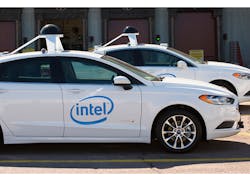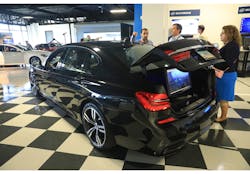Over the past few years, Silicon Valley has been breaking into the self-driving vehicle business at an accelerated pace. In the latest episode of a series worthy of binge-watching, Intel—the world’s largest semiconductor chipmaker, fresh from completing a $15.3 billion acquisition of autonomous driving technology startup Mobileye—announced plans to build a fleet of Level 4, fully self-driving vehicles for testing in the US, Israel, and Europe. The first 100 of these “highly autonomous” cars are set to hit the road later this year (Fig. 1).
These test vehicles will combine Mobileye’s capabilities in computer vision, sensing, fusion, mapping, and driving policy together with Intel’s open computing platforms and expertise in data center and 5G communication technologies, delivering what the company promises will be a complete “car-to-cloud” system. The fleet will include multiple car brands and vehicle types to demonstrate the technology’s agnostic nature (although the first batch is expected to be BMW 7 series sedans).
The print was hardly dry on the statement from Intel’s communications department when news broke that Fiat Chrysler Automobiles (FCA) has joined Intel, Mobileye, and the BMW Group in an effort to develop an autonomous driving platform that can be used “by multiple automakers around the world.” Commented FCA Chief Executive Officer Sergio Marchionne: “Joining this cooperation will enable FCA to directly benefit from the synergies and economies of scale that are possible when companies come together with a common vision and objective.”
Brian Krzanich, Intel CEO then chimed in, noting: “The future of transportation relies on auto and tech industry leaders working together to develop a scalable architecture that automakers around the globe can adopt and customize.” During his keynote speech at the most recent L.A. Auto Show, Krzanich said his company will spend $250 million over the next two years toward the development of autonomous vehicles.
Last year BMW Group, Intel, and Mobileye announced they were collaborating to bring solutions for highly automated driving (Level 3) and fully automated driving (Level 4/5) into production by 2021. Since then, they have been designing and developing a scalable architecture that is said to maintain each automaker’s unique brand identities. The threesome said they “invite and welcome additional automakers and technology suppliers to join them” in adopting this autonomous driving platform in an effort to create an industry-wide solution.
FCA’s most prominent foray into autonomous vehicles before this week’s announcement came in a deal to provide Waymo—the autonomous driving program from Google parent Alphabet Inc.—with 600 of its hybrid Pacifica minivans to be test beds for self-driving technologies. Earlier this year, Waymo unveiled its self-driving Chrysler Pacifica at the North American International Auto Show in Detroit. At the same event FCA displayed its Portal all-electric, self-driving concept car, which was featured at the Chrysler exhibit.
The Santa Clara-based Intel is also forming a big new data consortium with Toyota Motor Corp., telecom firm NTT Docomo, Ericsson, and Japanese auto parts maker Denso Corp. to determine how best to handle the coming deluge of car data on the horizon. Known as the Automotive Edge Computing Consortium, the group aims to use data in support of emerging services such as intelligent driving, mapmaking using real-time data, and driving assistance based on cloud computing.
With the slew of information captured by cameras, LIDAR, RADAR, and other sensors, autonomous cars are expected to generate some 4 terabytes of data every 90 minutes of operation. Most of this data will be processed, filtered, and analyzed in the car, while the most valuable data will be moved to the data center to update maps, enhance data models, and more.
Data volume between vehicles and the cloud is expected to reach 10 exabytes of data to the cloud every month by the year 2024—about 10,000 times more data than cars send to the cloud today—according to Toyota. Overall Intel estimates the vehicle systems, data, and services market opportunity to be up to $70 billion by 2030.
Back in May Intel opened its Silicon Valley Center for Autonomous Driving in San Jose, Calif. for a one-day autonomous driving workshop, providing insight into the company’s R&D efforts to push the boundaries of driverless cars and the future of transportation—including sensing, in-vehicle computing, artificial intelligence (AI), connectivity, and supporting cloud technologies and services. The company’s Silicon Valley Lab joins Intel’s other labs in Arizona, Oregon, and Germany. At the event, and for the first time in front of members of the press, BMW displayed one of the automated vehicles announced by the BMW, Intel, and Mobileye co-operative (Fig. 2).
According to a study released by Intel, autonomous vehicle technology (including ADAS and everything else that will have to be developed to mimic George Jetson’s mode of transport, sans the flying) will scale from $800 billion in 2035 (the base year of the study) to $7 trillion by 2050. The companies that don’t prepare for self-driving risk failure or extinction, in Intel’s stated view. The study, prepared by Strategy Analytics, predicts autonomous vehicles will create a massive economic opportunity. It also forecasts that an estimated 585,000 lives could be saved due to autonomous vehicles between 2035 and 2045.
As they say at the ballpark, you can’t tell the players without a scorecard, so here’s a quick review of three other notable autonomous car developments Silicon Valley has been involved in this year (and 2017 isn’t even three-quarters complete):
- The Alphabet-owned (once again, read: Google) company Waymo recently received a patent for technology that would soften a car’s body in the event of a collision with a pedestrian. The feature would change the rigidity of body panels, bumpers and the hood using underlying cables, rods, or springs. It would use these “tension members” to keep the exterior of the car rigid. In the event of a collision, the car’s sensors would trigger the release of these cables to collapse parts of the vehicle, reducing the force of the impact experienced during a collision.
- After a great deal of speculation, Apple CEO Tim Cook told Bloomberg in June (“admitted to” might be a better way of putting it) that the computer company is developing technology for a self-driving car, something he described as “the mother of all AI projects.” Cook said the artificial intelligence project involves three aspects: autonomous cars, electric vehicles, and ride-booking.
- The German automaker Audi has partnered with Nvidia technology to put Level 4 driverless vehicles on the road by 2020.



